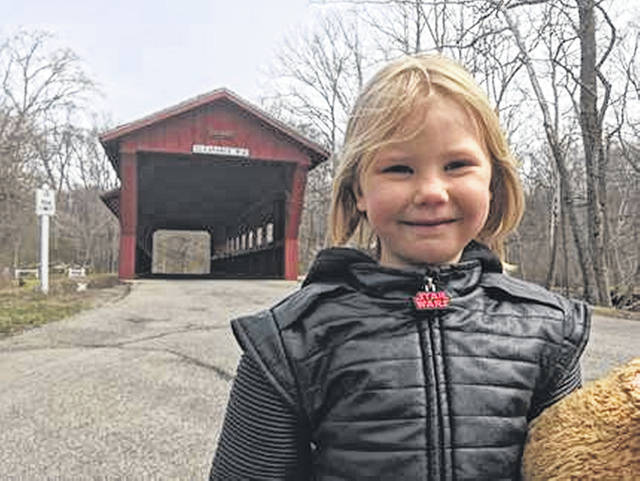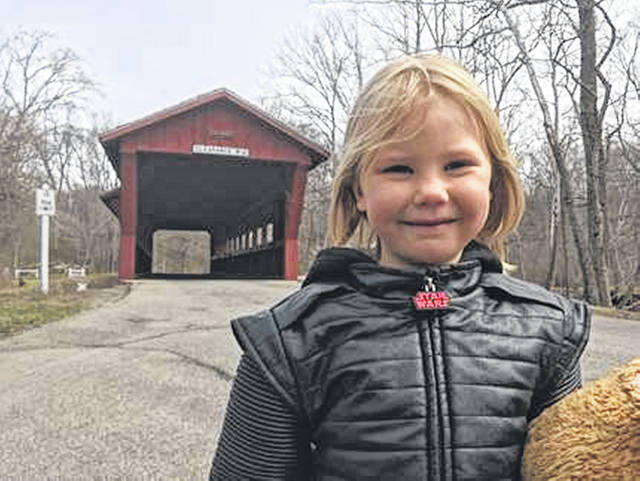

Editor’s note: This is the eighth in a series of stories to commemorate Tawawa Park, which celebrates its 70th anniversary this year. Today: bridges.
SIDNEY — Sometimes, if there’s no traffic behind him when Dave Ross drives through the covered bridge in Tawawa Park, he stops in the middle of the bridge amd honks the car horn.
It’s a salute to his dad, the late Bill Ross Jr., for whom the bridge is named.
“My dad was always a fan of covered bridges. I remember I’d be a passenger with him, and he’d say, ‘We have to take a back road because there’s a covered bridge there,” Dave said. “We’d get under the bridge. I always blew the horn.”
The elder Ross researched the bridges as a hobby. They were becoming rare even in Dave’s childhood.
“At that time, a lot of those bridges were real old and were in need of repair. They were a dying breed. When they were replaced, they were replaced without a cover,” Dave said.
It was Bill Ross Jr. who funded the construction and installation of a covered bridge in Kaser Dell in Tawawa Park in 1974.
“When Milligan Glen first needed to be accessed, there was a need for a bridge. The bridge existed for a few years before it was a covered bridge. (Dad) thought that was the right place for a covered bridge. It looks like it belongs there. It’s beautiful,” Dave said.
Bill had served on the city’s recreation commission and was its chairman for a time. An active community servant, he sat on committees, boards and councils for schools, children’s organizations, civic groups, arts organizers and social services agencies.
He based the design of the Ross Bridge on those designed in the 18th century by Reuben L. Partridge. The Tawawa Park expanse is well built.When parts of the bridge were washed away by flood waters in April, it was quickly repaired. Before it could be put back into service, however, it had to pass a state inspection.
“Based on the way it was supported, the inspector said, ‘This thing should be across I-75 instead of a creek,’” Dave said.
His father was once on a committee that developed a plan to recognize people who were responsible for creating and building Tawawa Park.
“I remember … how important my dad thought that was that those people be acknowledged. He would be pleased to know he is a part of that,” Dave said.
Davis Bridge sees foot traffic
While Ross Bridge gets about an equal amount of automobile and foot traffic, Davis Bridge is for walkers and cyclists.
Spanning Tawawa Creek, it connects softball fields with soccer fields in Baumgardner Basin and is named for the late Corliss E. “Corky” Davis.
Davis sat on the city’s recreation board for 25 years. During that time, Baumgardner Basin was acquired for the park, and Davis was particularly responsible for the development of softball fields.
According a story published in the Sidney Daily News when he retired from the recreation board in 1991, Davis oversaw park expansion to 13 ball fields.
“And we’re still short,” he said then.
Davis officiated football games from 1942 to 1981. He played fast-pitch softball in the mid-1940s and helped to start slow-pitch softball here in the mid-1950s. He also was involved in the creation of the VESPA club, an athletic booster organization.
By trade, he was a dairy inspector. He, like Bill Ross, acknowledged that no one can accomplish civic improvements alone.
“You can sit on any board, but unless you get cooperation of people, nothing happens,” he said in 1991.
The Sidney mayor proclaimed June 3, 1991 — the day Davis left the recreation board — Corky Davis Day in Sidney.
When asked by the newspaper how he would rank Sidney in the area of parks and recreation, Davis said, “I think Sidney is one of the best in the country for its size. I feel like I helped accomplish something. It’s a gratifying feeling.”
Park to get new old bridge
By the time Tawawa Park closes to vehicular traffic for the winter in 2019, it will sport a third important bridge.
The Ohio Department of Transportation is funding the refurbishment and installation of a historic two-span structure built by the King Bridge and Iron Co. in Cleveland in 1879.
It originally crossed the Loramie Creek north of Fort Loramie, not far from where Pierre Loramie had built his store centuries before.
The great flood of 1913 destroyed one of the spans.
“The remaining half was taken to private property,” said Duane Gaier, Sidney Parks and Recreation director, where it facilitated the movement of farm machinery. As that machinery increased in size, the bridge fell out of use.
Its current owner has donated it to the city, which will install it in Tawawa Park to connect two peninsulas that jut into Amos Lake.
“The new bridge will be for pedestrian use only,” Gaier said. Even bicyclists will have to walk rather than ride their bikes across it. Plans call for work to start in the spring of 2019 and for it be complete that fall.
The bow string bridge was discovered by architectural historian Mary Ann Olding, of Minster, when she was in the area three years ago to investigate an historic house.
“I alerted 50 people, and with the stone soup approach, we were able to save it and reuse it,” Olding said. “It’s an era in American history when these bridges opened the country to commerce, settlement and transportation. It’s very important.”
In the same way, the bridges in Tawawa Park tie together areas and users.
“(They) allow people to make connections,” Gaier said.


